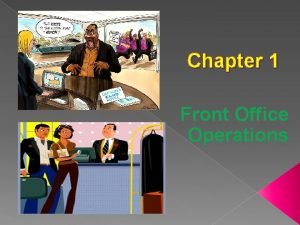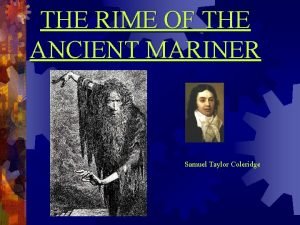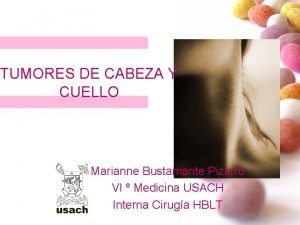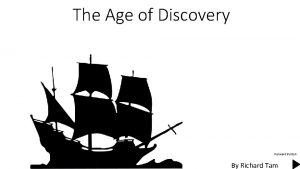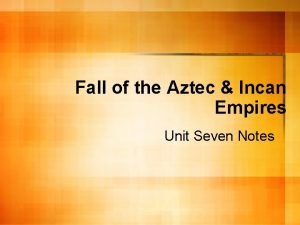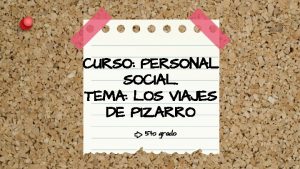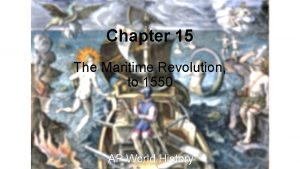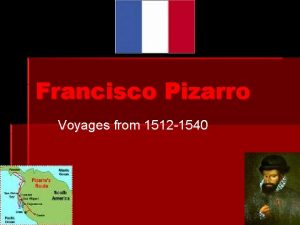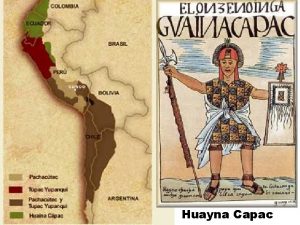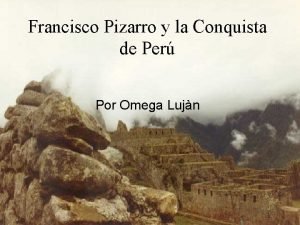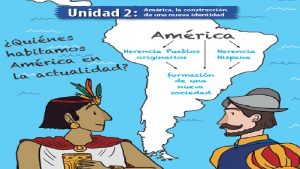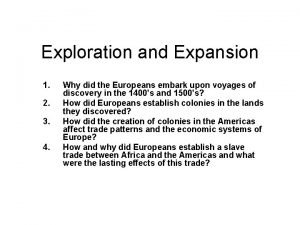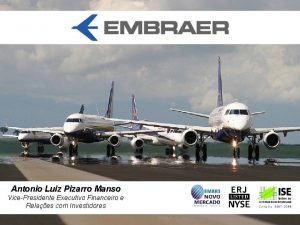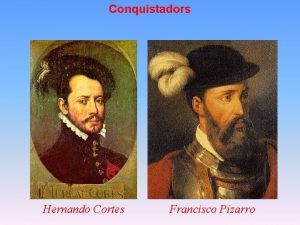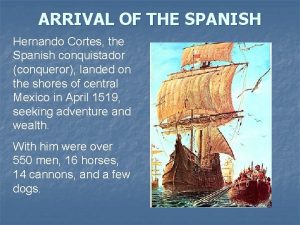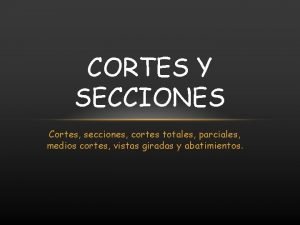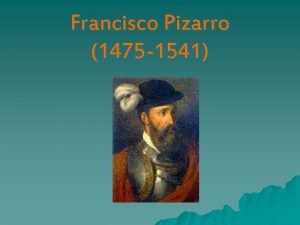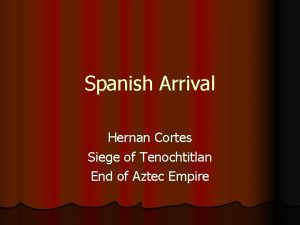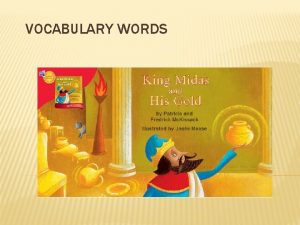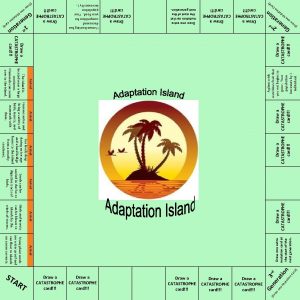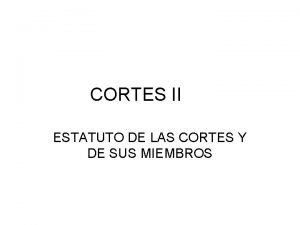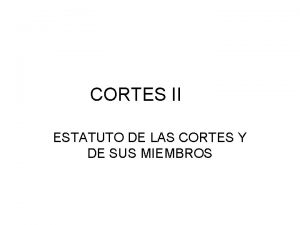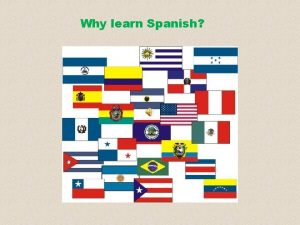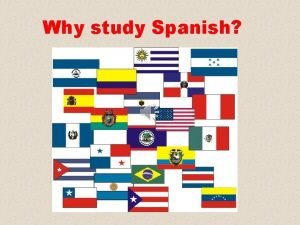Cortes and Pizarro Arrival of Spanish Cortes came





















- Slides: 21

Cortes and Pizarro

Arrival of Spanish • Cortes came in 1519 • Claimed land for Spain king and queen • He took 11 ships, 100 sailors, 500 soldiers, cannon, guns and horses • He met Aztec Ruler- Montezuma believed that Cortez was the pale, bearded god, Quetzalcoatl.

Clash of cultures “first encounter” “Spanish takeover” • The native/conquered peoples had to pay tribute (sacrifices) & taxes to Montezuma. They wanted their freedom. • Cortez wanted riches and gold! • Aztecs HELPED Cortez defeat Montezuma • (“Z” in both Cortez & Montezuma) Advanced weapons & diseases helped Spain conquer the Aztec

Pizarro

Europeans Arrive in S. America • Francisco Pizarro lands on coast of Peru with a crew of 167. He soon met the Incas and their ruler, Atahualpa. • Atahualpa was not worried about this small crew of Spaniards even though they had strange weapons, horses and soldiers. • Pizarro’s men climbed the Andes Mtns. , they agreed to meet Atahualpa. At the meeting, they arrested Atahualpa and kept him prisoner for 8 mos. Atahualpa agree to give them gold and silver in exchange for his freedom. Pizarro went back on his word. Once he received the gold & silver, he had Atahualpa executed. The Incan Empire was taken down by 167 men.

Europeans Establish Control - Incan empire now destroyed. All the gold and silver melted down. - Spanish took over Incan territory (most of S. America) - Soon after Portugal sent explorers who took over Brazil

Quick Review What advantages did the Spanish have over the Aztecs and the Incas? The Spanish soldiers had steel swords, armor, guns, and cannons, as well as horses. Most importantly they also had Native American allies. What proved to be the most deadly for the Aztecs and the Incas? Why? Small pox and other diseases from Europe killed millions of Native Americans had no immunity to because it had never before existed in the Americas. Most of the Native American population died because of diseases brought by the Europeans.

Founding of New Spain • Spain set up new villages & a different (European) way of life • The European settlers brought animals not native to Latin America- horse, cattle, pigs • New trades- iron smithing, ship building • Christianity – Europeans were now converting native population to Christianity. • Spanish were Catholics • God, Glory and Gold!

Influence of the church • Missionaries set up new churches, hospitals, schools • The Native Americans who survived the European diseases had to give up their religion, languages & way of life


Mexico’s War for independence • Miguel Hidalgo- a creole (Spaniard born in the New Word) priest helped free Mexico. He was supported by native Indians and Mestizos (Indian & Spanish blood). • Mestizos helped fight for independence • Struggled with lack of weapons- Hidalgo was executed • Mexico nobles continued fight- finally freed

Colonial S. America - Spanish and Portuguese settled in S. America - Most of the Native Americans died from disease brought by Europeans. The settlers needed workers and turned to Africa. - Europeans made Africans into slaves to farm their plantations (sugar cane) - Europeans got wealthy from resources in their colonies

Columbian Exchange Pros • Blended culture • Easier trade • Introduced NEW foods, animals, medicines and minerals Cons • Disease • Slavery • Conflict/war

Many ideas, goods & customs were exchanged…but unfortunately so were people… • The natives of Latin America were first used to work the farms. But when European diseases killed most of the workers, European land owners turned to Africa and began using slaves.

What resources did the Europeans introduce to Americas during the Columbian Exchange? Europe • • • Horse Pig Cows Wheat Oranges minerals Americas

What resources did the Americas introduce to Europeans during the Columbian Exchange? • • Americas Europe Cacao Corn Potatoes Chili peppers Medication Llamas Tortillas

Independence • Money made from S. American colonies and goods were sent back to Spain and Portugal • Mestizos and mulattos (white & black heritage) wanted change- treated like slaves • S. Am. decides to fight for independence.

Haiti’s Independence Movement • Toussaint L'Ouverture was the son of an educated slave in Haiti. L’Ouverture wanted to put an end to slavery and gain Haiti’s independence from France. • L’Ouverture and his fighters used guerrilla warfare – ambushes/raids, hit and run tactics • The success of the Haitian Revolution shook the institution of slavery throughout the New World. • Haiti gained its independence in 1803.


Gaining Independence • Like Mexico’s independence from Spain, S. Am. Was fighting for their independence too. • Simon Bolivar (a wealthy creole in Venezuela) led South America’s war for independence. • By 1825 almost all S. America is freed from European control • Bolivar is known as “el Libertador” • What country is named for him?

 Cortes and pizarro venn diagram
Cortes and pizarro venn diagram Sub department of front office
Sub department of front office Rime of the ancient mariner ending
Rime of the ancient mariner ending Pamela pizarro alvarez
Pamela pizarro alvarez Marianne del carmen bustamante pizarro
Marianne del carmen bustamante pizarro Hernan cortes route
Hernan cortes route Aztec empire
Aztec empire Ruperto pizarro leyton
Ruperto pizarro leyton Mapa conceptual del tercer viaje de pizarro
Mapa conceptual del tercer viaje de pizarro Zayla pizarro
Zayla pizarro Age of exploration ap euro
Age of exploration ap euro Francisco pizarro voyages
Francisco pizarro voyages Gerardo pizarro
Gerardo pizarro Pedro j. pizarro
Pedro j. pizarro Diego de almagro
Diego de almagro Francisco pizarro
Francisco pizarro Viaje de pizarro
Viaje de pizarro Gerardo pizarro
Gerardo pizarro Francisco pizarro
Francisco pizarro Francisco pizarro area of exploration
Francisco pizarro area of exploration Pizarro incas
Pizarro incas Luiz pizarro
Luiz pizarro

